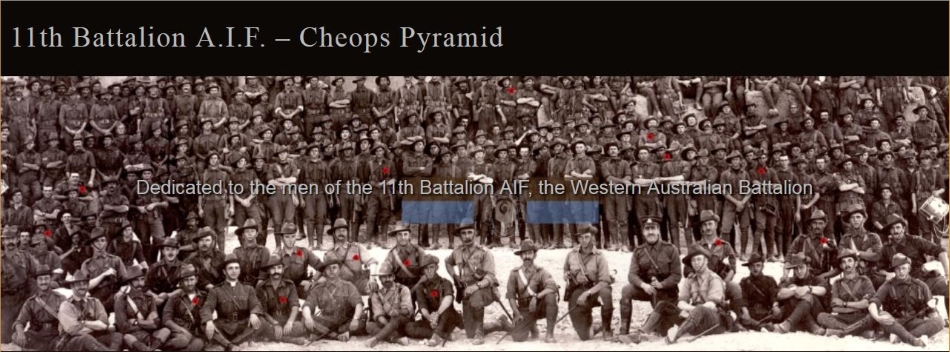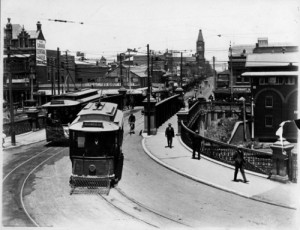 David John SIMCOCK - KIA - ID# 15
David John SIMCOCK - KIA - ID# 15
I carnt berleeve he's gorn - Pore ole Pink
He was just a private, one of the many in the original 11th Battalion and yet everyone knew him. His shock of bright red hair made him instantly recognizable, but it was his magnetism, his humour, his personality which stood him apart from the others.
In 1914, aged 31 with a wife, two children and a fruit and vegetable business to manage, he could have easily left the fighting to younger men but he was amongst the first to enlist when the call went out for recruits for the Australian Infantry Forces.
In due course, Private David John Simcock, for that was his name, even warranted a 13-line reference in CEW Bean's Official History of Australia in the War of 1914-18.
At certain points of Walker's Ridge the Turks attacked fiercely. In parts the gullies in front were too steep to allow of organised assault. But near its foot and near the Top they constantly approached.
In the lower third of the spur was a single post, about thirty strong, under Captain Critchley-Salmonson of the Canterbury Battalion. This post was continuously pressed. Salmonson's men consisted partly of New Zealanders and partly of men of the 11th and 12th Battalions from Baby 700 and The Nek.
One of these was a red-headed fruit-seller well known in Perth, Western Australia, as Pinktop, under which name he traded. He was a strange, ungainly, splay-footed soldier. His main anxiety – sedulously encouraged by his mates – had been how he should face barbed wire, and he had solved the problem by putting tin guards beneath his putties.
His sergeant had ordered him to remain on the Beach as a sentry over the men's packs, but he refused, and came on with the rest. In the fighting on Sunday night – in an endeavour, it is said, to bring a wounded man into cover – Private Pink Top was killed.
Early life
Little was known about his life before he arrived in Western Australia, however the following article from the Sunday Times sheds some light
…..there are many South Australians to whom Dave Simcock was well-known, but by none was he held in higher esteem than by Mrs. Ross of ‘The Grange' who knew ‘Pink Top' from boyhood, and knew and understood him as few people ever could do. The story of his early life as gleaned from this lady is deeply interesting. 'Pink Top' was 'pure gold' in this lady's estimation.
As a boy of 12 [sic] he was the main support of the family, his father having died of a very painful and lingering cancer. His sister was also very ill for some time. Dave was the man of the house - its adviser in all things even then, in fact his one thought was of and for his own people. Thus early were the finest traits of his many-sided character formed and developed. It was at Port Pirie that "Pink Top' first took to the barrow and he soon made money where others would starve.
He was a born coster. His originality was irresistible and this evoked that bright repartee and captivating humor that were so well known to all with whom he came in contact.
Yet Dave Simcock had a deeply serious side to his nature. He hated pretence in anything or anybody. In his early battles for a living for his family "Pink Top' made a confidante of Mrs. Ross, and in this particular respect the secret springs of feeling and action that lay beneath the surface….. and which by many would be disregarded, were sacred matters to Dave, so much so that Mrs. Ross could only be induced to refer to them in a truly sympathetic manner.
Duty was his lode-star all the time, and his example of enterprise and energy is worthy of emulation by all whose hopes and aspirations found such expression as to lead dear old 'Pink Top' eventually to 'do and die' for his King and country…..
(Sunday Times 1915 18 July p2)
'Pink' in Egypt
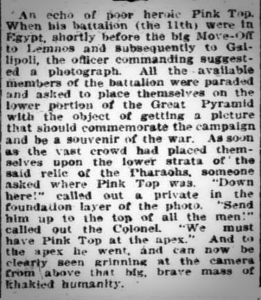 David Simcock appears uppermost in the 11th Battalion photograph on the Cheops Pyramid (ID#15) and a story which debuted in the Sunday Times of 7 January, 1917 and which has become part of the folklore about ‘Pink Top’ indicated that he was sent to the topmost position by Lt. Colonel Lyon- Johnston. However, Private James Brown, a recruit from the Perth suburb of Leederville, puts a different slant on Pink Top’s position in the Cheops photograph. Brown wrote in his diary on Sunday 10 January 1915...
David Simcock appears uppermost in the 11th Battalion photograph on the Cheops Pyramid (ID#15) and a story which debuted in the Sunday Times of 7 January, 1917 and which has become part of the folklore about ‘Pink Top’ indicated that he was sent to the topmost position by Lt. Colonel Lyon- Johnston. However, Private James Brown, a recruit from the Perth suburb of Leederville, puts a different slant on Pink Top’s position in the Cheops photograph. Brown wrote in his diary on Sunday 10 January 1915...
At last we got away to the church parade & after that a march past, where our moving pictures was [sic] taken.
We then lined the Pyramids to have our photo taken, myself & a few others, we were too high up & out of focus for the photographers. So down we had to come.
'Pink Top' was the highest up now.
William Harold Simcock
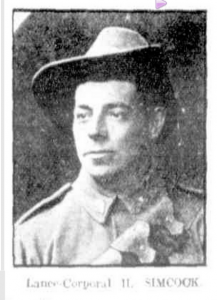 There is little doubt that the staff of the Sunday Times were admirers and supporters of Pink Top and the frequent anecdotes about him which appeared in the columns of this Perth newspaper require some caution in their retelling.
There is little doubt that the staff of the Sunday Times were admirers and supporters of Pink Top and the frequent anecdotes about him which appeared in the columns of this Perth newspaper require some caution in their retelling.
In October 1917, David’s widowed mother Bertha was living in Lake Street, Perth and it was there that she learned that the second of her three sons, William Harold Simcock who had enlisted in South Australia in January 1916 had been killed in action in France.
Another cruel blow for the Simcock family - a second boy lost and buried in a foreign land.
James Hurst, author of the engrossing story of the 11th Battalion at Gallipoli, Game to the Last has generously given permission to reproduce here, his telling of Pink Top’s short and colourful life.
The Bloke with the Pink Top - by James Hurst
It ‘was a sad day’ for employees of the markets when Pink Top’s horse was auctioned. Perhaps his wife and children were there; perhaps it was the last place they wanted to be. The fruit seller had achieved a lot before his life ended at Gallipoli.
David John Simcock had moved to Perth from South Australia in the first decade of the twentieth century. He tried a number of ways to earn a living before investing in a fruit barrow to sell fruit in the city.
Simcock’s hair was ‘pink – not red’, and he was soon trading as ‘The bloke with the Pink Top’, or ‘Pink Top’. What really set Pink Top’s business apart was his personality — he was a great spruiker.
The stories about him are many and legendary. The West Australian newspaper stated at the time:
‘His altogether novel methods of effecting rapid sales, his known wit and his no mean gift as an orator, made him a conspicuous figure and he soon became one of the identities of the city.’
Barrack St, Perth c1910
Pink Top became the ‘object of much press attention as columnists, humourists, social writers and journalists chronicled his witty sayings and often spectacular doings.’ The hardworking barrow vendor was soon doing well enough to establish a shop in the city.
So popular did he become that crowds ‘would gather to hear his spiel and read his witty signs.’
On at least one occasion so many people stopped to listen that they blocked the tram-lines, and Pink Top was taken to court for causing an obstruction.
In response he changed his signs in order to attract less of a crowd, inspiring him to quip:
‘No more they’ll plant their number nines, to block the tram, or steed.
He’s putting up some altered signs, that they who run may read.’
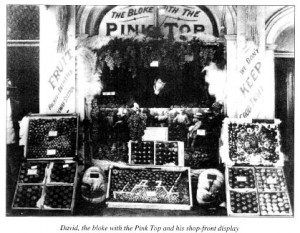 By 1914 things must have been going well for David Simcock. He now had a shop in Fremantle and was selling fish.
By 1914 things must have been going well for David Simcock. He now had a shop in Fremantle and was selling fish.
He corresponded with the state premier, had married and been blessed with a daughter and son, aged 8 and 4 respectively, and had become a household name in Perth and Fremantle. But then came the war.
The 31-year-old father and businessman volunteered and became Private D.J. Simcock, 11th Infantry Battalion, the first battalion raised in Western Australia for the AIF.
Hedley Howe later wrote that
‘The highest tribute Australian soldiers ever paid to any of their comrades was “He is a good soldier”.’
Although ‘clumsy and untidy in dress’, Simcock soon earned that title. His ‘doggerel about the Army and its officers’, ‘never failing sense of humour’ and ‘endless repertoire’, ensured that he became well known and popular in camp.
Aboard the troopship carrying the battalion to Egypt were 2000 troops and one canteen. For a small commission, Pink Top took orders and money from the troops, queued up and collected and distributed the goods.
‘He never made a mistake and no-one begrudged the commission he earned.’
In fact, at Aden, with no shore leave granted, Simcock used his takings to buy crates of oranges from the boat-borne vendors and distributed them gratis to the troops.
During the men's training in Egypt, Simcock corresponded with the West Australian Premier Jack Scaddan,
‘but what he had to say therein is certainly not for publication’.
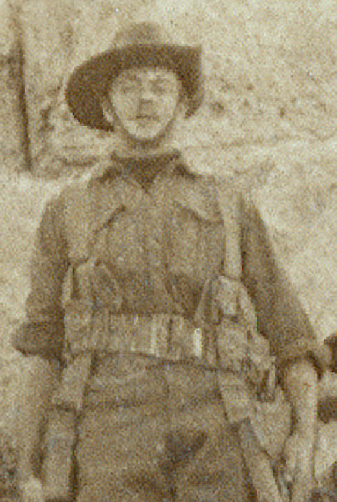 Like many others, Simcock took unofficial leave over the Christmas period, and, not for the first time, took the punishment metered out to him.
Like many others, Simcock took unofficial leave over the Christmas period, and, not for the first time, took the punishment metered out to him.
The 3rd Brigade were soon aboard troopships once more, being briefed for the impending operations at Gallipoli. At the end of one briefing, Lieutenant Mort Reid finished with the customary ‘Any questions?’ A pause followed, after which Pink Top requested an answer to an undocumented but ‘still unsolved question about barmaids’.
He was also concerned about submerged barbed wire. He put his mind to work and, ‘sedulously encouraged by his mates’, paraded before the colonel with his solution – ‘a pair of leggings fashioned from a biscuit tin worn under the puttees.
The colonel’, it would seem ‘was not impressed’.
Little is known about Pink Top’s experience of what is probably Australia’s best known battle – the Gallipoli Landing. The unit history states that
‘poor old Pink Top' was killed early in the action through bobbing up and down in the trench, trying to get a look at what was going on. Unfortunately he bobbed up once too often.’
The context of this account implies that this took place on 7 May, or nearly two weeks after the Landing. One newspaper account, written many years after Simcock’s demise, stated that
‘On May 2, 1915… while leading a charge against the Turks after his company commander had been killed’, Pink Top ‘had his head blown away by a piece of shrapnel…’
A letter at the time stated that ‘the officer in charge of his company was shot down and there being no-one to lead the men, Pink Top volunteered and took command. He gave the order to charge and they did not stop until poor Pink Top had just gained the top of the hill. Just as he said “Come on, boys” he was hit full in the face by shrapnel and blown to pieces.’
Other stories also found their way home. Only one eye-witness account of Simcock’s movements on 25 April exists.
Sergeant George Mason, Simcock’s sergeant, recalled that Pink Top was detailed to remain on the beach to guard the men’s packs, but he refused to be left behind and advanced inland with his platoon. This determination, to the point of turning a blind eye to orders, may ultimately have cost him his life. Mason and Reid accompanied a party that fought on the high ground of the left flank of the landing – the experience of their party, under Captain E.W. Tulloch, is well documented and a part of both history and folklore. Reid died there somewhere. Mason survived and that night was still fighting. Pink Top was with him. He ventured forward into the unknown to bring in a wounded man and did not return.
There is a rumour that his unofficial tin leggings, visible beneath his tattered puttees, enabled his body to be identified a month later and buried. Many others who disappeared at the Landing have no known grave.
Ironically, on the day Pink Top probably met his end, the Sunday Times newspaper, wrote that they had received a postcard from Cairo of ‘Pink Top drinking beer on the Pharaoh's Sarcophagus’.
After the war Pink Top’s identity disc was recovered and sent to his wife.
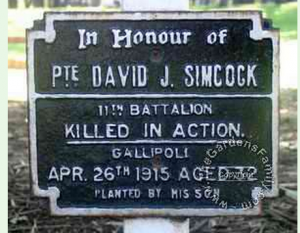 In Perth’s King’s Park are many plaques commemorating the First World War’s dead.
In Perth’s King’s Park are many plaques commemorating the First World War’s dead.
One belongs to Lieutenant Charles Pope, the only member of the 11th Battalion to be awarded the Victoria Cross during the First World War. The award was posthumous. Alongside is the plaque to Private John ‘Simpson’, actually John Simpson Kirkpatrick, famous as ‘the man with the donkey’. The next plaque bears the name of a private killed in his first day of war, fruiterer, father and volunteer of the first contingent, David John Simcock.
His body lies on foreign soil among Australians and New Zealanders killed on 25 April after gaining the high ground that towers over the Anzac position.
In Perth, his memorial plaque lies alongside those of a Victoria Cross recipient and national legend.
‘Pink Top’ is in good company.
Pink - a tribute by 'Dryblower'
The final words about David Simcock are more appropriately left to his great friend at the Sunday Times and very likely the creator of the story about his position on the Cheops Pyramid, West Australian bush poet, Edwin Greenslade Murphy who wrote under the pen name 'Dryblower' His column Verse – and worse published on Sunday 15 June, 1915 contained the following poem, in the style of C. J. Dennis’s The Sentimental Bloke....
PINK
I carnt berleeve he's gorn
— Pore ole Pink —
Bullet 'it an' shrapnel torn,
In a wink,
Cos us wot knoo ‘im well
Seemed ter think 'e 'ad a spell
Wot ud git ‘im out of ‘ell
Fair the dink.
‘E was “Pink Top" with the mob
Good ole Pink!
But with business on the job
‘E could think.
'E never whined nor wailed.As a friend 'e never failed.
An' menny a bloke ‘e's bailed
Outer clink'E was allus
Pink to us
Pushin' Pink
In an argument or fuss
Or a drink,
Though 'e couldn't fight for nuts,
They got all the upper-cuts,
Cos yer see, 'e 'ad the guts
Wotter yer think?
I’ve seen ‘im in a brawl
Full of ink.
Where a burly man might crawl
Round the brink
He’d take one on the chin,
Then remove his ten quid grinAn’ then ’e’d fight, an’ win
Pie for Pink!
'Ard of chivvy, 'e was fair
Soft inside:
Ev'ry kid with ginger 'air
Was 'is pride.
One Christmas Eve
-no kid-
‘E slings a Gord-forbid
A dinkum 'arf-a-quid
'Cos it cried.
Church religion wasn't much
Good to Pink:
'E earned 'e's kids an'
Dutch Food an' drink,
"An menny a zac 'e's passed
To break a battler's fast
"Bellies first an' bibles last,"
Sed ole Pink.
We bin on the razzle once
Me an' Pink:
Just a day,
an’ not for munce,
Did we drink.
Though politeness wasn't prim,
No one in that shickered swim
‘Till they'd ‘ad a drink with 'im
Paid for Pink.
When 'e joined I said to Pink
‘Wot’s the wheeze?
Are yer kiddin’
– is it drink Or the cheese?"
"No," ‘e said,
"but somethin' came
And got me in the game,
An' so I bogged me frame
Inter these."
'E went tearin' at the Turk,
Game an' good;
‘E got in some willin' work
Like 'e would.
Wot 'e 'ad ter give 'e gave.
An' in a foreign grave .
'E's sleepin like a brave
- Soldier should!
Dryblower
Acknowledgements
We gratefully acknowledge and thank James Hurst for his support of the WAGS 11th Battalion Project and his permission to reproduce the article 'The bloke with the Pink Top’ as published in Soldiers Tales 2: a collection of true stories from Aussie Soldiers, edited by Denny Neave.
We also thank Michael Pope, great nephew of David Simcock for submitting information about David Simcock.
Additional material researched and written by Julie Martin
References
Brown, James Ser# 1049 – Diary (Private collection)
Soldiers Tales 2: a collection of true stories from Aussie Soldiers, edited by Denny Neave. Big Sky Publishing, 2012
Trove. Australian Newspapers online. www.trove.nla.gov.au/newspaper
